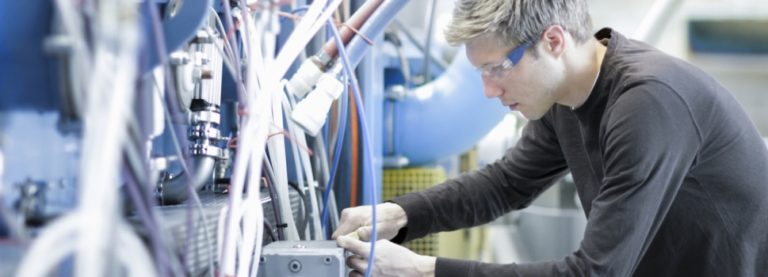By Vincent Chu, Senior Content Marketing Manager, PARC
For the new year, we asked 18 of our researchers and staff members from around PARC to share some of their technology predictions for 2018 and beyond. Here’s what they said:
 More learning from less data
More learning from less data
“Deep learning and deep reinforcement learning has revolutionized data analytics, but the amount of data required is still relatively huge. It’s also not how humans learn – typically a few examples are enough to form a mental model. I think this is going to change as research shifts from feasibility and accuracy to scalability and transparency. There’s already some work in this area of slow learning, including from PARC, and this will only get more prominent.” – Raj Minhas, VP, Director of Interaction and Analytics Lab
 Age-responsive design
Age-responsive design
“Responsive design is about adapting an experience for a user. So why are websites still one size fits all? Just as digital advertising tailors content to the specific interests and demographics of its users, I think we’ll start seeing websites adapting their content to different ages, from children to the elderly.” – Cristina Gaitán, UX Designer and Researcher, Innovation Services Group
 Printed electronics
Printed electronics
“Electronics will continue to be ‘freed from the box’ in exciting ways. Advancements in form and shape, integrating micro and macro, flexible hybrid circuitry, printed batteries. Electronics manufacturing will become more accessible, on-demand and personalized, and the privileges of large companies will now be available on a desktop or at the corner shop. We’ll also see higher levels of complexity, with computation doubling alongside microelectronics in exponential ways.” – Janos Veres, Program Manager, Novel and Printed Electronics
 Internet of things
Internet of things
“IoT will continue to change every industry that touches it, but rather than providing simple telemetry and control of existing business processes it will shift into determining business strategy as prescriptive AIs identify emergent organizational opportunities and threats and plan alternative strategies. In contrast, people will increasingly have to develop everyday AI literacy as systems built to exploit human cognitive biases become more sophisticated and prevalent.” – Mike Kuniavsky, Principal UX Designer and Researcher, Innovation Services Group
 Electrification of thermal processes
Electrification of thermal processes
“We’ll begin to see electrification of thermal processes. An example is hot water heaters, which use natural gas (thermal) to heat water. Replacing these with electrical water heaters gives a “knob” to turn to control electricity demand. This is important for grid stability: with increasing penetration of renewables and extreme weather events, we need to be able to control when loads turn on and off to ensure supply meets demand. PARC has several projects converting thermal processes to electrical.” – Jessy Rivest, Area Manager, Energy Materials & Systems
Learn more about innovation at Xerox
Futuristic breakthroughs are already underway. Learn more on Xerox.com and PARC.com as well as these Xerox Connect tags: Innovation, PARC, Xerox Research Centre Canada
 Human-machine interaction
Human-machine interaction
“As autonomous systems become more competent, the need for interacting with machines will only increase. This will happen on both ends of the spectrum: in building smarter machines and in working with smarter machines. While general AI is still far away, there will be a trend towards “teaching by showing.” This theme involves a number of challenging angles like trust, transparency, and collaboration and is also an area where PARC is doing some interesting work.” – Kyle Dent, Research Manager, Interaction and Analytics Lab
 Transfer learning
Transfer learning
“I think we’ll see significant progress in transfer learning, for example in other domains like healthcare and social sciences, making use of the typical machine learning use cases to solve some of their “low-hanging fruit” problems such as classification and regression. Also, traditionally, machine learning algorithms have been applied to predictive analytics problems in the industry. We’ll see a lot more generative applications this year.” – Kalai Ramea, Researcher, Interaction and Analytics Lab
 Industry 4.0 coming of age
Industry 4.0 coming of age
“In 2018, we’re going to see clear impact from Industry 4.0, or the fourth industrial revolution. There’s an enormous digital opportunity for traditional industry that’s ripe for incumbents and startups alike and I predict that we’re going to see several large industrial firms making major announcements and new product introductions in the intersection of physical industrial infrastructure and digital services.” – Markus Larsson, VP of Global Business Development
 Connecting digital and physical design
Connecting digital and physical design
“In recent years, how we design services have been defined by and limited to digital screens. As a result, people spend more time interacting via device than in person. I think this will begin to shift due to growing angst about “screen addiction” and core technology components being increasingly embedded in different environments. My guess is we’ll see digital brands place greater emphasis on physical presence and soon we’ll find it harder to separate digital and physical design, they’ll be one and the same.” – Frances Yan, UX Designer and Researcher
 Automation for the people
Automation for the people
“The continued commodification of key automation components is enabling a whole generation of applications — cars driving themselves, plants being monitored and pruned in agricultural fields, knots being tied in surgery. While this is wildly exciting, it’s highly disruptive and will restructure our economy from top to bottom. More thinking will go toward harnessing this productive power in a way that society can widely accept and benefit from.” – Bob Price, Researcher, Machine Learning
 Better batteries
Better batteries
“The continued advancement of batteries in terms of cost, energy storage and charge times will only propel electric car adoption further in 2018. My guess? Electric cars will reach more than 5% market share in 2018, up from around 2% today.” – Dan Davies, Researcher, Interaction and Analytics Laboratory
 AI in healthcare
AI in healthcare
“The implementation of different AI and machine-learning techniques in healthcare will only continue to grow. We’ll see the impact of AI and systems engineering in diagnosis, pharmacy, a doctor’s performance analysis, workflow improvements. I believe we’ll also see more virtual and augmented reality in healthcare in 2018.” – Marzieh Nabi, Director of Business Strategy, Global Business Development
 The radar era
The radar era
“To date, lidar and camera have reigned the automotive sensor space for autonomous driving. The radar sensor was always considered the underdog because of its poor resolution, even though it’s the only weather-proof and long-range sensor. By using engineered metamaterials for beamshaping, and embedding an AI engine, we’re giving the radar true vision and intelligence, yielding enhanced perception of the world. This is the beginning of the radar era.” – Bernard Casse, CTO and Co-Founder of Metawave, former PARC Area Manager
 Technology to support aging in place
Technology to support aging in place
“Many developed nations cannot afford to care for all the elders in the baby boomer generation. So, they’ll continue to need to find solutions that allow people to age in place, either with mechanical support or support from other people mediated by, and possibly monitored and reimbursed by, software technologies.” – Victoria Belloti, Research Fellow, Innovation Services Group
 Robots in the lab
Robots in the lab
“I think in 2018 we’ll see more biology laboratories starting to move into the cloud, leverage robot technology. The impact could be immense, as technology can eventually re-produce the procedures of scientific experiments without humans, helping with reproducibility challenges, and reducing the cost of checking and reviewing scientific experiments.” – Soichiro Iga, Innovation Services Group, Japan
 Rapid consumerization of healthcare
Rapid consumerization of healthcare
“Consumers have a plethora of choices when it comes to connected health-related devices. Take for instance Kardia’s AliveCor, an FDA-approved medical-grade EKG recording device that connects to your smart phone. Users can record accurate EKGs throughout the day and share the data with their doctor. As more and more devices come to market, healthcare providers will be forced to consume the resulting data to make better provider decisions.” – Tim Curley, Senior Director, Global Business Development
 Cryptocurrencies
Cryptocurrencies
“Cryptocurrencies can be seen as the next technological iteration of value tracking in our civilization. While they face challenges with scalability, energy efficiency, security, we can expect those to be resolved in a horizon of next decade. The cryptocurrency whose community is able to resolve these challenges fastest will become the value-holding currency and dominate 80% of the market. Bitcoin has a head-start and we could see it reach $60,000 per coin and $1 trillion market capitalization in 2018.” – Filip Dvorak, Researcher, System Sciences Lab
 Sensing, computation and blockchain
Sensing, computation and blockchain
“I see two significant emerging trends for 2018 and beyond. The first has to do with the confluence of sensing and computation that is providing data at increasingly finer spatial and temporal resolutions and sensitivities, yet at the same time with increasingly high-level autonomous extraction of meaning and development of contextual knowledge. The second is the maturation of blockchain-related technologies, which together with the first trend, will create and incentivize a globally-distributed, decentralized knowledge network and marketplace that rewards contribution and therefore continually refines its understanding of the physical world. When combined with a capacity for actuation, this will usher in the era of automation.” – Alex Hegyi, Research Scientist, Electronic Materials and Devices Laboratory
From the editor: This article first appeared on the PARC blog.




[…] for 2018 (Added 12/15/17) Top 10Technology Trends in Health Insurance: 2018 (Added 12/21/17)18 Technology Predictions for 2018 from PARC Researchers (Added 12/30/17) Healthcare Artificial Intelligence, Machine Learning and Related Predictions […]